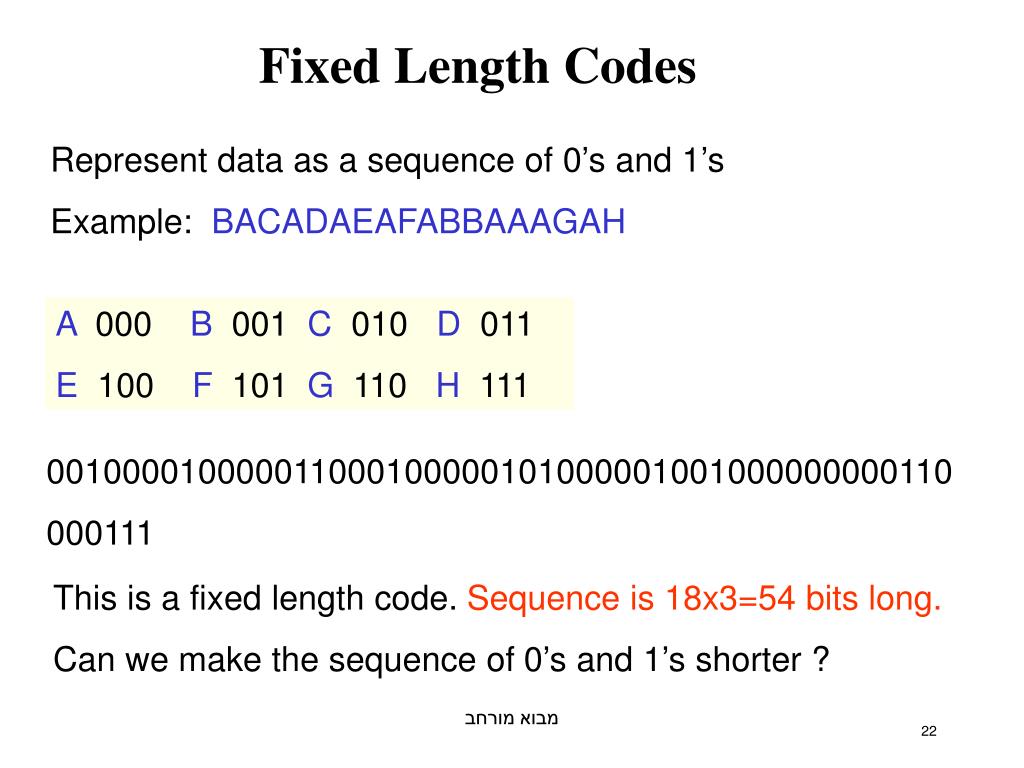Fixed Length Encoding (FLE) signifies a robust and structured approach to data representation within the realm of computer science. At its core, this encoding method assigns a constant number of bits to each symbol or value, facilitating uniformity in the representation of information. This characteristic simplicity has led to widespread applications across various domains, propelling both efficiency and clarity in data handling. The appeal of fixed-length encoding extends beyond its surface level; it delves into the intricacies of data compression, storage optimization, and algorithmic prowess.
To grasp the significance of fixed-length encoding, one must first appreciate the duality of data representation paradigms. In contrast to variable-length encoding, where symbols can possess differing bit-lengths, fixed-length encoding ensures that every symbol is allocated an equal quantity of bits. For instance, if a coding scheme designates 8 bits for each character in a string, every character, regardless of its nature, is encapsulated uniformly. This predictability fosters ease of access and retrieval, enhancing computational efficiency.
One of the paramount benefits of fixed-length encoding lies in its ability to expedite data processing. Consider the implications of a scenario where a processor must interpret varied bit-lengths for different symbols. Such variability introduces complexity—compounding the difficulty of indexing and navigating the dataset. Fixed-length encoding mitigates this challenge. By standardizing data representation, computational systems can seamlessly traverse data structures, leading to expeditious access and processing times. This is particularly salient in applications demanding real-time data manipulation, such as multimedia processing and data streaming.
Moreover, fixed-length encoding contributes significantly to storage optimization. In scenarios where efficiency is paramount, allocating a uniform bit-length can minimize the overhead associated with data management. For example, binary files—common within computing—benefit from fixed-length encoding, as it ensures that each entry occupies the same physical space. This consistency can lead to more effective memory allocation strategies, ultimately translating into cost savings, as larger datasets can be managed without necessitating exorbitant storage resources.
The implementation of fixed-length encoding is often contextualized within established coding schemes. A quintessential example of this is ASCII (American Standard Code for Information Interchange), which encodes characters as 7 or 8 bits. Each character is systematically assigned a specific binary representation, exemplifying the fixed-length principle. Beyond ASCII, many other encoding schemas—UTF-8 and UTF-16 among them—incorporate fixed-length encoding for certain values, emphasizing their adaptability and relevance across diverse computational languages.
At its zenith, fixed-length encoding transcends mere efficiency. Its implications extend into the realm of cryptography, where security protocols often leverage fixed lengths for generating hash values and encrypting data. The consistency inherent in fixed-length encoding complicates potential breaches, thereby enhancing data security. When cryptographic systems employ fixed-length outputs, the predictability serves as a deterrent against attackers who may otherwise discern patterns in variable-length outputs. This nuanced intersection between encoding practices and information security underscores a deeper fascination with fixed-length encoding, revealing the multidimensionality of its applications.
However, fixed-length encoding is not devoid of limitations. Notoriously, it can lead to suboptimal data representation, particularly when the dataset contains symbols with a range of complexities and frequencies. In instances where the dataset comprises predominantly low-frequency symbols, the fixed-length schema may generate redundant entries, resulting in wasted space. This inefficiency unveils a paradox at the heart of fixed-length encoding, juxtaposing its appeal against the realities of varied data landscapes.
Thus, the pursuit of fixed-length encoding often coexists with methodologies that aim to balance the dichotomy of uniformity and flexibility. While fixed-length encoding remains a stalwart in simplicity and efficiency, variable-length encoding schemes provide necessary alternatives when data diversity demands a more nuanced approach. For instance, Huffman coding serves as a striking counterpoint, enabling more adaptive representations that reflect symbol frequency distributions yet sacrificing some of the rapid, predictable access offered by fixed-length schemes.
The fascination with fixed-length encoding is palpable in its capacity to streamline operations and foster computational harmony. As systems articulate their processes through layers of encoding, the significance of fixed-length encoding becomes ever more pronounced. It invites contemplation of broader implications: How do we prioritize simplicity and efficiency in a world inundated with complexity? In a sense, fixed-length encoding crystallizes a solution, inviting both practitioners and theorists alike to explore its depths and discern its multifaceted implications.
In summation, fixed-length encoding stands as a cornerstone in the algorithmic landscape of computer science. It encapsulates a duality of efficiency and clarity, illustrating the necessity of structured data representation while acknowledging its limitations. As the field continues to evolve, understanding and appreciating the implications of fixed-length encoding becomes paramount. Its enduring relevance lies not only in its utility but also in the philosophical inquiries it provokes regarding the nature of data representation and the intricate dance of uniformity within a diverse computational universe.








Leave a Comment